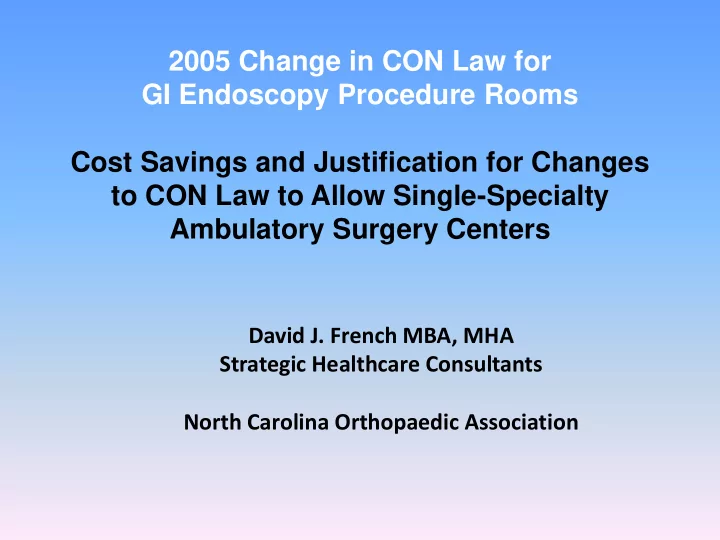

2005 Change in CON Law for GI Endoscopy Procedure Rooms Cost Savings and Justification for Changes to CON Law to Allow Single-Specialty Ambulatory Surgery Centers David J. French MBA, MHA Strategic Healthcare Consultants North Carolina Orthopaedic Association
2005 Change in CON Law for GI Endoscopy Procedure Rooms During the six years following the 2005 change in the CON law, 47 new ASC facilities were developed. GI endoscopy procedure rooms in ASCs increased from 56 to 175.
GI Endoscopy Procedure Volumes Total utilization for GI endoscopy procedures increased by 28 percent over the four years following the change in the CON law. Some of this increase is “normal growth” due to the aging population. Utilization declined in the most recent two years, due to the downturn in the economy.
Total savings related to the shift from hospitals to ASCs far exceeded the increase in expenditures for facility reimbursement. The total net savings over 6 years is estimated at $224,605,748 . . Calculate Additional Endoscopy Volumes and Facility Reimbursements that Calculate Cost Savings for Endoscopy Procedures Performed in ASCs Resulted from Additional Endoscopic ASCs Following the 2005 Change in instead of Hospitals CON Law A B C D A B C D Normal Expected Reimbursement of Growth Due to Additional ASC Total Estimated Population Growth Procedures Based Procedures Average Cost Savings for and Aging (3.0% Additional on $445 per Actual Shifted to ASCs Savings Per ASC Annual Increase for Actual Utilization Procedures Procedure for Procedures from Hospitals Procedure Procedures All Population Over 45 for ASCs and Attibuted to ASCs Facility Fees North North Performed in (75% Estimate (Facility Rates Payors + years) Hospitals (B minus A) (C times $445) Carolina Carolina ASCs X A)* Only)** Patients 2004-05 462,542 462,542 0 2004-05 51,028 0 NA NA 2005-06 476,418 489,899 13,481 $ 5,998,929 2005-06 98,588 73,941 345 $25,509,645 2006-07 490,711 551,484 60,773 $ 27,044,071 2006-07 165,337 124,003 345 $42,780,949 2007-08 505,432 585,024 79,592 $ 35,418,381 2007-08 233,740 175,305 345 $60,480,225 2008-09 520,595 591,693 71,098 $ 31,638,567 2008-09 270,180 202,635 345 $69,909,075 2009-10 536,213 564,997 28,784 $ 12,808,903 2009-10 277,714 345 $71,858,498 208,286 2011-12 552,299 573,551 21,252 $ 9,456,990 2011-12 295,394 345 $76,433,198 221,546 3,544,211 3,819,190 274,979 $ 122,365,841 1,391,981 1,005,715 $346,971,589 Even without the change in the CON law in 2005, growth in GI endoscopy * On average, 75 percent of the volume growth in colonoscopy and would occur due to population growth and aging. Between 2000 and 2010 endoscopic GI procedures was due to a shift in site of service. From "An the NC population over 45 years of age had a compound annual growth rate Analysis of Recent Growth of Ambulatory Surgery Centers" by KNG of over 3 percent. Consulting. ** Average savings per endoscopy procedure are estimated based on a Increased availability of endoscopy procedure rooms in ASCs supported broad range of endoscopy procedures with ASC paid 56% of the rates paid greater access, higher efficiency and increased physician productivity. to hospitals.
Operating room capacity in North Carolina is dominated by hospitals even though the majority of surgical cases are ambulatory. Surgical cases performed in ASC’s are reimbursed at 56% of the rates paid to hospitals for the same procedures.
Types of Existing and Approved Ambulatory Surgical Facilities 2012 Licensed Surgical ASCs Totals ASCs Multi-specialty Ophthalmic Obstetrics Orthopaedic (Excludes ASCs Having Only GI Plastic ASCs ENT ASC ASCs ASCs ASCs ASCs Endoscopy Rooms) ASCs with Physician Ownership w/o 30 16 8 4 2 0 0 Hospitals ASCs with Hospital Ownership 12 12 0 0 0 0 0 (wholly or percentage) 42 28 8 4 2 0 0 Totals 13 9 0 0 0 3 1 ASC Facilities in Development
Comparison of Percentages of Cases by Payor Category for Multispecialty ASCs Physician Owned as compared to Hospital Owned Physician owned multispecialty ASCs serve higher percentages of Medicaid and Medicare patients. Multispecialty ASCs owned by hospitals provide higher Commercial Insurance and Self Pay / Indigent / Charity.
2011 Procedure Volumes and Top Physician Specialties on ASC Medical Staff Highest Procedure Volumes by Specialty Performed in NC Surgical ASCs Ophthalmology 57,345 Orthopaedics 32,134 Otolaryngology 24,381 General Surgery 8,597 Obstetrics and GYN 6,626 Plastic Surgery 2,746 Highest Volumes of Non-Surgical Procedures Performed in NC Surgical ASCs Pain Management 20,760 Yag Lasers 5,563 Top 6 Physician Specialties on ASC Medical Staff (This is not a measure of physician ownership) Anesthesia 294 Orthopaedic Surgeon 338 Gynecologist 244 Ophtalmologist 246 Otolaryngologist 182 General Surgeons 178
North Carolinians Have Limited Access to ASCs 2012 North 2010 US Carolina Totals Total Licensed ASCs 96 5,316 (Surgical and Endoscopy) Population 9,781,022 308,745,538 ASCs per 100,000 0.98 1.72 Population ASCs per 2012 Licensed 2012 States CON Status 100,000 ASCs Population Population Virginia CON Required 51 8,001,024 0.64 North Carolina CON Required 96 9,781,022 0.98 South Carolina CON Required 75 4,625,364 1.62 Tenessee CON Required 162 6,346,105 2.55 Exemptions for Single Specialty Georgia 333 9,687,653 3.44 and JV ASC with $ Thresholds No CON Florida required for 422 18,801,310 2.24 ASC
Rationale for Changing CON Law to Allow CON Applications for Single-Specialty ASCs Ambulatory surgical centers (ASCs) provide tremendous cost savings to patients, insurance companies and government payors Proposals can be submitted by physicians, hospital-owned physician groups or other legal entities including joint ventures This change will increase competition and patient access ASCs will be required to provide specific levels of care to Medicaid and Charity patients and to provide annual reports This change in the CON law will support the future recruitment of physician specialists to North Carolina This change will increase investment in facilities, create jobs and expand the tax base
Recommend
More recommend